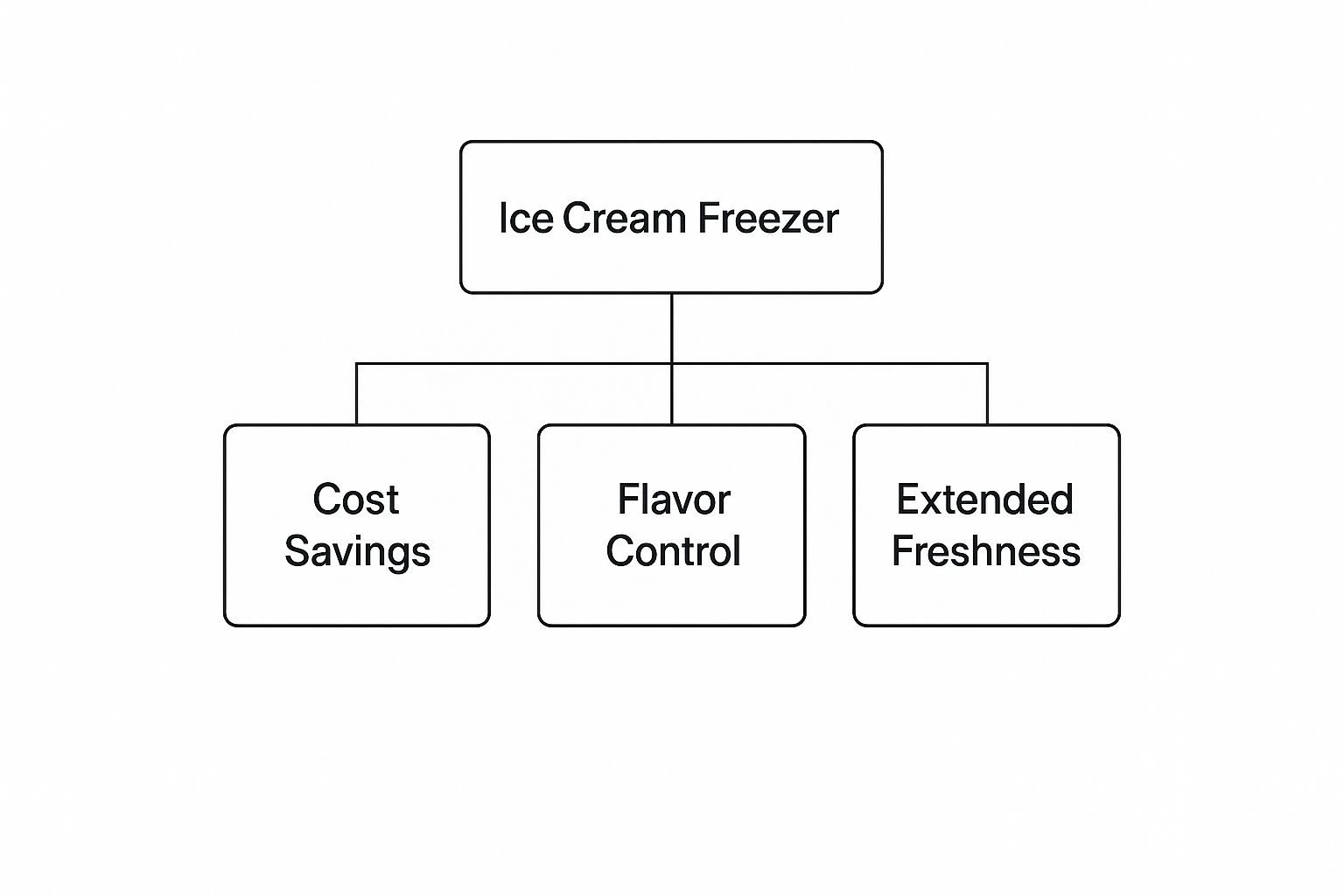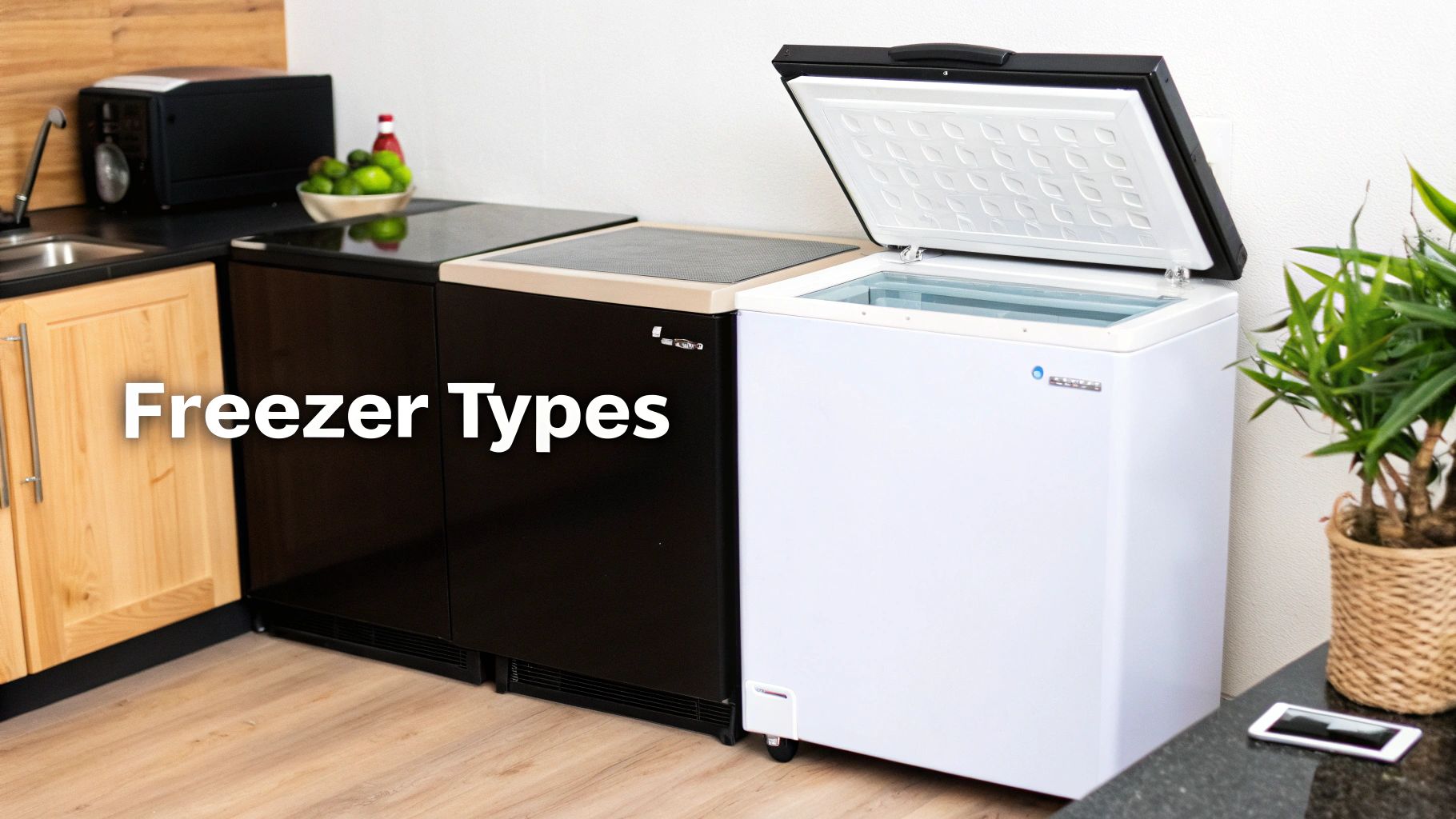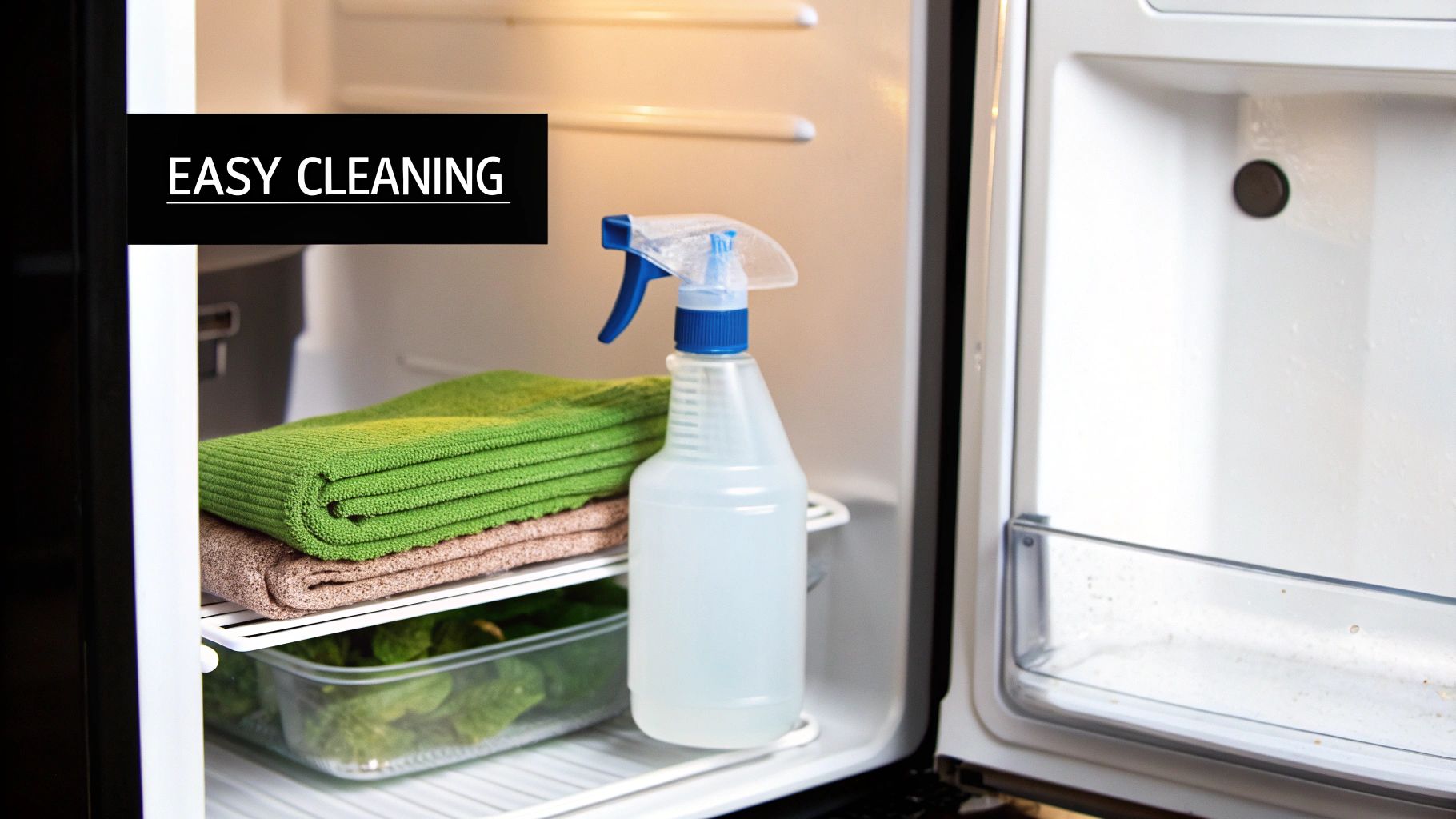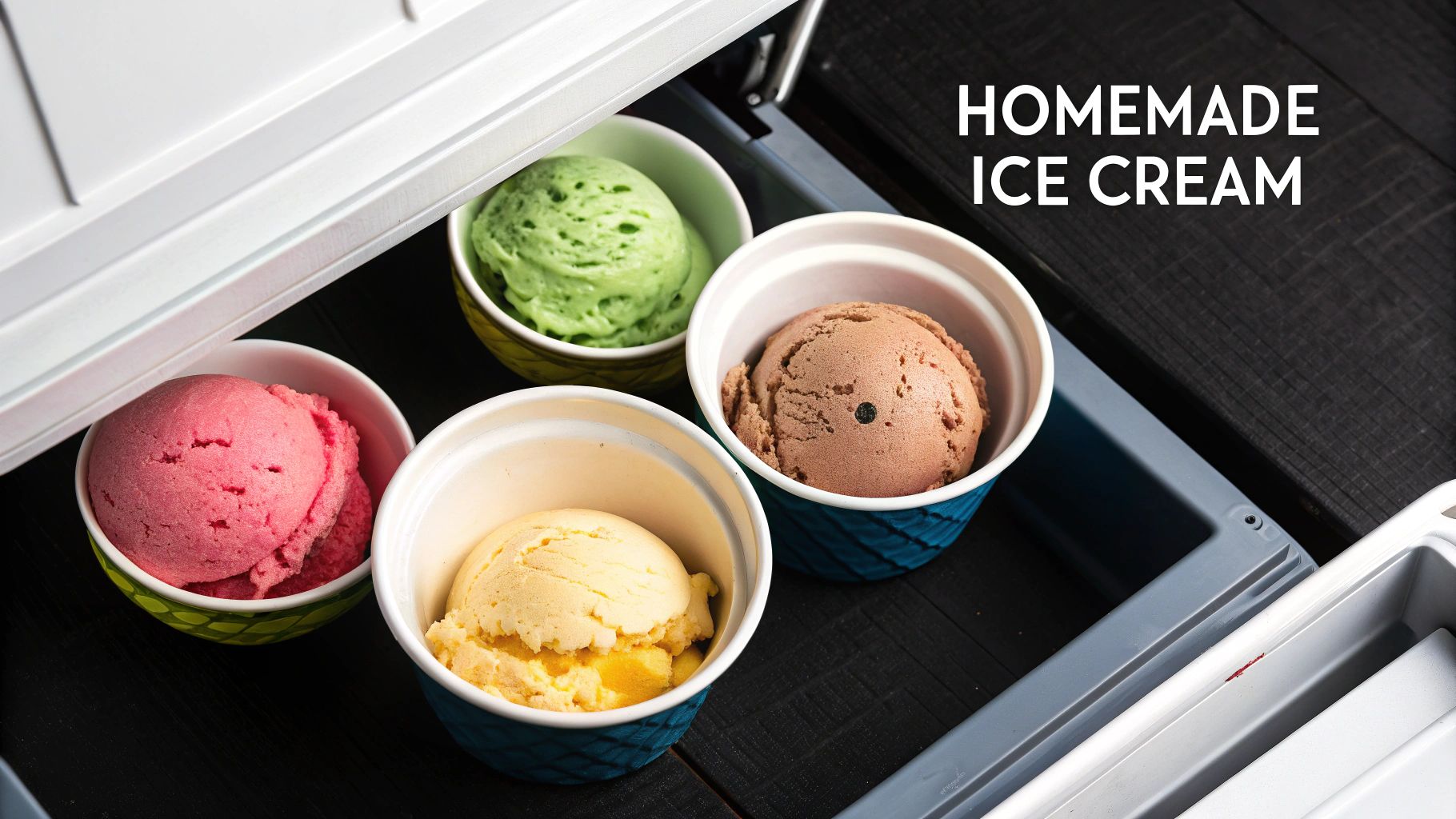
Choosing Your Perfect Ice Cream Freezer
Share
An ice cream freezer isn’t just another appliance in your kitchen; it's the heart of your entire dessert operation. It’s the gatekeeper of quality, making sure every single scoop you serve is just as perfect as the last. Getting this choice right is a foundational decision that ripples through everything—from the taste of your product and the smoothness of your workflow to keeping customers happy and your business profitable.
Finding the Right Ice Cream Freezer for Your Business
Think of choosing an ice cream freezer like picking the right tool for a job. You wouldn't use a screwdriver to hammer a nail, right? The same logic applies here. The perfect freezer for a bustling ice cream parlor is completely different from what a small café or a convenience store might need. Your business's unique rhythm and goals will point you to the right choice.
This decision is more important than ever, especially with the world's sweet tooth for frozen desserts only getting bigger. The global market for ice cream freezers is set to hit around $2.5 billion by 2025, with steady growth of about 5% expected each year through 2033. That growth tells you one thing: investing in the right equipment isn't just a good idea; it's essential to keep up.
This image breaks down exactly why a quality freezer is such a smart investment.

As you can see, the right unit is about more than just keeping things cold. It leads to real business advantages, like saving money on energy, keeping flavor locked in, and making your product last longer. So, let's dive into the main types of freezers and figure out which one fits your operation.
Quick Comparison of Ice Cream Freezer Types
Before we get into the nitty-gritty, this table offers a quick snapshot to help you match a freezer type to your business needs. It's a great starting point for figuring out where your focus should be.
| Freezer Type | Primary Use Case | Best For | Typical Capacity |
|---|---|---|---|
| Dipping Cabinet | Front-of-house scooping and display | Ice cream parlors, scoop shops | 8-16 tubs (3-gallon) |
| Chest Freezer | Back-of-house bulk storage | Any business needing inventory | Multiple 3-gallon tubs |
| Glass Top Display | Self-service retail sales | Convenience stores, cafes | Pre-packaged novelties |
| Specialized Freezer | Production or limited space | Food trucks, in-house production | Varies by specific unit |
This table should give you a clear idea of the main players in the ice cream freezer world. Now, let's explore what makes each one tick.
Dipping Cabinets: The Star of the Show
If your staff is scooping ice cream directly for customers, the dipping cabinet is your non-negotiable centerpiece. It's the vibrant, customer-facing star of your shop, designed with an open top and a glass sneeze guard for quick, easy access to all your flavors.
The whole point of a dipping cabinet is service, not long-term storage. It’s built to hold your ice cream at the perfect scooping temperature while showing off that beautiful, colorful array of options. In a way, it’s as much a merchandising tool as it is a freezer.
Chest Freezers: The Back-of-House Workhorse
Behind every great dipping cabinet, you'll almost always find a reliable chest freezer. These are the unsung heroes of your operation, the workhorses dedicated to keeping your backup inventory deeply frozen and perfectly preserved until it's ready for its moment in the spotlight.
A chest freezer's primary job is to maintain a consistent, ultra-low temperature. This is absolutely critical for preventing nasty ice crystals from forming and for protecting that creamy, smooth texture your customers love.
Since they aren't opened nearly as often as a dipping cabinet, they provide a super-stable environment for holding those big, 3-gallon tubs. This ensures you never have to tell a customer you're out of their favorite flavor during a busy rush.
Glass Top Display Freezers: The Silent Salesperson
You’ve seen these everywhere—in convenience stores, supermarkets, and cafes. Glass top display freezers are basically silent salespeople. They’re designed for self-service, letting customers browse and grab pre-packaged treats like ice cream bars, sandwiches, and pints on their own.
The sliding glass lids give a great view of the products inside while keeping the cold air locked in, making them surprisingly efficient. They are an absolute must-have for driving impulse buys in any retail-focused business.
Specialized Freezer Units
Beyond the big three, a few specialized units are out there for specific situations. Countertop freezers, for instance, are compact powerhouses perfect for places with limited space, like a food truck or concession stand. They can hold a few key items right at the point of sale.
And for businesses that make their own ice cream from scratch, a batch freezer is the essential tool of the trade. This is the machine that actually churns and freezes your ice cream base into the finished product. Pairing a batch freezer with the right storage and serving units gives you a complete, in-house production line. To really complete your setup, you might also want to check out our guide on the best restaurant stainless steel tables for your kitchen.
Decoding the Features That Truly Matter
Staring at a spec sheet for a new ice cream freezer can make your head spin. It's a jumble of technical terms and feature lists, making it tough to know what's actually going to help your business versus what’s just marketing fluff. Let's cut through the jargon and translate it into what really matters for keeping your product perfect and your bottom line healthy.

First, let's get one common misconception out of the way: the standard freezer you have in your garage simply won't do the job. To keep ice cream smooth and scoopable—and to stop those big, unappetizing ice crystals from forming—it needs to be held at a consistent, deep-freeze temperature.
The gold standard for holding ice cream is a frigid -10°F to -20°F (-23°C to -29°C). This is worlds colder than a typical home freezer, which hovers around 0°F, and it's absolutely essential for preserving the quality of your product.
That ultra-low temperature is the single most important feature that sets a commercial ice cream freezer apart from any other freezer. It’s the non-negotiable foundation for serving a perfect scoop, every single time.
Defrost System: The Quality vs. Convenience Tradeoff
One of the biggest decisions you'll face is choosing the defrost system. The two main options, manual and auto-defrost, present a classic trade-off between protecting product quality and making your life easier.
A manual defrost freezer is exactly what it sounds like. You’ll have to periodically turn it off, empty it out, and let the built-up ice melt away on its own. While this sounds like a chore, this process creates the most stable temperature environment possible. Without any internal heating cycles, the temperature stays consistently frigid, which is perfect for long-term storage and preventing freezer burn.
On the other hand, an auto-defrost (or frost-free) model has a small internal heater that cycles on and off to melt ice from the cooling elements. It’s incredibly convenient and saves a ton of labor, but those small temperature swings can, over time, take a toll on the delicate texture of your ice cream.
- Choose Manual Defrost for: Your back-of-house bulk storage, where product quality is the absolute top priority and tubs might sit for a while.
- Choose Auto-Defrost for: High-turnover dipping cabinets where convenience is king and the ice cream is being sold quickly anyway.
Construction and Insulation: Built to Last and Save
The daily hustle of a busy kitchen demands equipment that can take a beating. That's why stainless steel construction is the undisputed champion for any quality ice cream freezer. It’s tough, it resists rust and corrosion, and it’s a breeze to sanitize—a must for food safety.
But what's on the inside is just as critical. The thickness and quality of the freezer's insulation have a direct line to your energy bill. Thicker, high-density foam insulation (polyurethane is a common choice) works as a better barrier, meaning the compressor doesn’t have to kick on as often to maintain those ultra-low temperatures.
A well-insulated freezer will:
- Use far less electricity, lowering your utility costs.
- Put less wear and tear on the compressor, extending the life of the unit.
- Get back down to temperature much faster after the lid has been opened.
Investing in a unit with tough construction and top-notch insulation really does pay for itself over time in energy savings and fewer maintenance headaches. As you optimize your kitchen, remember that other equipment choices are just as important. For example, you can learn more about selecting the right commercial ice machine in our detailed guide.
The Refrigerant Factor
Finally, it pays to check what kind of refrigerant the freezer uses. Modern, eco-friendly refrigerants like R290 (propane) are quickly becoming the new industry standard, and for good reason. They have a much lower environmental footprint and are often more energy-efficient than older types. Choosing a unit with these greener refrigerants isn't just a responsible move; it's a smart long-term investment as regulations on older coolants get stricter.
Calculating Your Ideal Freezer Size and Capacity
Picking the right size for your ice cream freezer feels a bit like a Goldilocks story. If you go too big, you're just paying to keep empty space cold. Go too small, and you’re setting yourself up for stock shortages and lost sales right in the middle of a rush. It’s all about striking that perfect balance between what you need today and where you see your business going tomorrow.
This decision is more important than you might think. The market for frozen dessert equipment is booming—it was recently valued at around USD 13.2 billion and is expected to climb to USD 23.1 billion by 2034. That tells you one thing: customer demand is soaring, and having the right gear is non-negotiable. For a deeper dive, you can explore the full report on refrigerated ice cream merchandise.
To get this right, we need to stop thinking in inches and feet. Let's start thinking like pros and use the industry standard: the 3-gallon tub. This is the real currency of ice cream storage and the key to accurately figuring out your needs.
How to Calculate Your Flavor Capacity
First things first, let's figure out just how many tubs you need to hold. This isn't just about your total stock; it’s about what needs to be in the dipping cabinet versus what's waiting in back-of-house storage.
Start by asking yourself a few simple questions:
- How many different flavors do you plan to offer at any given time? Every single flavor needs its own spot in the dipping cabinet.
- How many backup tubs will you need for each flavor? You might need two or even three backups for your heavy hitters like vanilla and chocolate. For that quirky, niche flavor? One backup might be plenty.
- What does your peak season look like? Your freezer has to handle the summer heatwave demand without you having to make frantic calls to your supplier.
Let’s run a quick example. Say you want to serve 12 flavors and keep at least one backup tub for each. Right off the bat, you need space for 24 tubs. But wait—four of those are bestsellers that burn through inventory, so you want an extra backup for each. Your total just jumped to 28 tubs. Now you have a concrete number to work with when you're looking at different freezer models.
Balancing Display and Storage Needs
That simple calculation brings up a really important point: the difference between your display capacity and your storage capacity.
A classic rookie mistake is buying a beautiful dipping cabinet that fits one of every flavor, but completely forgetting where the backup tubs will live. This leads to jamming them in a less-than-ideal freezer or, worse, running out of a popular flavor mid-shift.
The smart approach is to map out what you need for both your front-of-house and back-of-house operations.
- Display Capacity (Dipping Cabinet): This is all about what you want your customers to see. An 8-tub cabinet works great for a small café adding a gelato program. A dedicated scoop shop will probably need a 16-tub model to really show off its range.
- Storage Capacity (Chest Freezer): Think of this as your inventory vault. It needs to be big enough to hold all your backup tubs and keep them at a consistent, deep-freeze temperature. This is crucial for preserving the texture and quality of your ice cream.
Planning for Growth and Efficiency
Here’s a final piece of advice: always buy a freezer with a little more room than you think you need right now. Hopefully, your business will grow. You’ll want to add seasonal specials, test out new flavors, or maybe just expand your core offerings. Investing in a slightly larger ice cream freezer today will save you the headache and expense of buying a second one a year from now.
Also, think about your supply chain. If your supplier delivers twice a week, you can get by with less storage space. But if deliveries only come once every two weeks, you’ll need a much larger capacity to hold you over. Factoring this in from the start ensures your freezer helps your workflow, rather than becoming a bottleneck.
Building Your Perfect Dessert Prep Station
A great ice cream shop is more than just a top-notch ice cream freezer. It’s about the flow. It’s about creating a smooth, efficient workspace where your team can serve customers quickly without tripping over each other. Your prep station is the command center for your entire dessert operation, and it all starts with the right work surface.

When you're talking food prep, stainless steel is the undisputed champ of the kitchen. Its non-porous surface is a dream to sanitize, which is non-negotiable in any food business. Plus, it's tough as nails and can handle daily abuse without rusting or warping. But not all prep tables are created equal. You can get creative by adapting different types of stainless steel tables—originally meant for savory foods—to build the ultimate dessert assembly line. This smart approach keeps everything organized, chilled, and right where you need it.
Standard Stainless Steel Work Tables
The most straightforward and flexible choice is the standard stainless steel work table. Think of it as your blank canvas. These tables come in a ton of different sizes and often have an adjustable undershelf—perfect for stashing extra containers, small appliances, or backup supplies. Their biggest advantage is giving you a clean, durable, and wide-open space for all sorts of tasks, from portioning toppings to assembling complex sundaes. Placing a large work table next to your dipping cabinet creates a dedicated finishing zone, preventing bottlenecks and making the entire process, from scoop to handoff, run like a well-oiled machine.
Sandwich and Salad Prep Tables
Now let's get clever. A sandwich or salad prep table is a refrigerated workstation with built-in cold wells on top, designed to hold pans of ingredients. While usually filled with lettuce and deli meats, they are absolutely brilliant when repurposed for desserts. Just imagine those refrigerated wells holding a colorful array of fresh toppings:
- Freshly sliced strawberries and blueberries
- Chocolate chips and rainbow sprinkles
- Gummy bears and chopped nuts
- Whipped cream and hot fudge
By using a sandwich prep table, you keep all your most popular and perishable toppings perfectly chilled and organized right at the point of assembly. This not only maintains food safety and quality but also dramatically speeds up service.
The refrigerated cabinet underneath is gold, providing fantastic storage for backup toppings, sauces, and other cold items. It's an all-in-one dessert powerhouse.
Pizza Prep Tables
Pizza prep tables offer a similar edge with a different layout. Instead of recessed wells, they have a raised, refrigerated rail that runs along the back of the work surface. This design is perfect for keeping ingredients handy without eating up your main prep space. For an ice cream shop, that raised rail is ideal for holding squeeze bottles of chocolate, caramel, and fruit sauces. It's also great for pans of smaller dry toppings. You still get that big, flat workspace out front for building elaborate sundaes, milkshakes, or banana splits. This combination of chilled ingredient access and ample prep area makes it a fantastic, high-efficiency choice for more complex dessert menus.
Adapting Prep Tables for Your Dessert Menu
See how features from different prep tables can be repurposed to create an efficient ice cream or dessert station.
| Prep Table Type | Key Feature | Ice Cream Shop Application |
|---|---|---|
| Standard Work Table | Large, open work surface | Assembling sundaes, decorating cakes, general prep |
| Sandwich/Salad Table | Refrigerated top wells | Holding fresh fruit, candies, and perishable toppings |
| Pizza Prep Table | Raised refrigerated rail | Storing sauces in squeeze bottles and dry toppings |
Ultimately, picking the right prep station means taking a hard look at your menu, your layout, and your team's workflow. By creatively adapting these versatile stainless steel tables, you can design a system that works in perfect harmony with your ice cream freezer to serve up delicious desserts with serious speed and precision.
Protecting Your Investment with Proper Maintenance
Let's be honest, your ice cream freezer is the heart and soul of your dessert service. It's not just some box that keeps things cold; it's the guardian of your product quality and, by extension, your good name. Keeping it in peak condition isn't just a good idea—it's non-negotiable. A happy, well-maintained freezer prevents those disastrous, middle-of-a-heatwave meltdowns and actually maximizes its own lifespan, making sure your investment pays off for years to come.

Think of this section as your straightforward maintenance playbook. We'll break down the crucial steps, from the day it’s installed to a simple, repeatable cleaning schedule you can actually stick to. When you understand the "why" behind each task, you can stop reacting to problems and start preventing them, saving yourself from the headache and cost of emergency repairs.
Getting the Installation Right
Proper care starts the second your new freezer arrives. A botched installation can doom a unit from day one, forcing it to work harder, guzzle more energy, and ultimately fail years before it should. It’s like building a house—if the foundation is crooked, nothing else will ever be right.
There are two things you absolutely have to get right: ventilation and leveling.
-
Proper Ventilation: The freezer's compressor and condenser are working hard to pull warmth out of the cabinet, and that process generates a lot of heat. They need room to breathe to get rid of it. Shoving a freezer right up against a wall or boxing it in without enough clearance is a recipe for disaster. The trapped heat forces the compressor into overdrive, jacking up your energy bills and leading to a premature burnout. Always follow the manufacturer’s guidelines for clearance, which is usually at least 3-4 inches of open space on all sides.
-
Perfectly Level: Your freezer needs to sit completely flat on the floor. If it’s tilted, even a tiny bit, the doors or lids won’t create a perfect seal. This lets warm, moist air sneak inside, leading to frost buildup, a constantly-running compressor, and a serious threat to the texture and safety of your ice cream. Grab a level and adjust the unit's feet until it's rock solid.
Creating a Simple Maintenance Schedule
Once your ice cream freezer is installed correctly, consistent, proactive care is what will give it a long life. You don’t have to be a refrigeration expert; you just need a routine. Breaking tasks down into daily, weekly, and monthly checks makes it all feel manageable and, more importantly, incredibly effective.
A regular maintenance schedule isn't just about cleaning; it's about catching small issues before they become catastrophic failures. A dirty coil or a worn-out gasket is a cheap fix, but a failed compressor can cost thousands and shut down your business for days.
Just follow this simple schedule to keep your unit humming along.
Daily Checks (Less Than 2 Minutes)
These quick, daily habits are your first and best line of defense.
- Verify Temperature: First thing every morning, glance at the external thermometer. Make sure it’s holding steady in that sweet spot of -10°F to -20°F. Any major swings are an early red flag that something isn’t right.
- Wipe Down Surfaces: Clean up any drips or spills on the outside and inside right away. This stops sticky messes from setting in and keeps everything looking professional.
Weekly Tasks (About 10-15 Minutes)
These weekly jobs are all about the seals that keep the cold air in and the warm air out.
- Clean Door Gaskets: The gaskets are the rubber seals around the doors and lids. They’re magnets for grime and sugar residue, which makes them brittle and unable to form a tight seal. Wipe them down with a soft cloth and some warm, soapy water. A tight seal is one of the easiest ways to make your freezer more efficient.
- Inspect for Damage: While you're cleaning the gaskets, give them a quick once-over. Look for any rips, tears, or spots that feel hard or brittle. A damaged gasket is a massive energy leak and needs to be replaced right away.
Monthly Chores (About 20-30 Minutes)
This is probably the single most important maintenance task you'll do. Once a month, you need to give the condenser coils a good cleaning.
These coils are what release all the heat pulled from inside the freezer. They naturally get covered in dust, grease, and all the other gunk floating around a kitchen. When they get clogged, the freezer simply can't get rid of heat efficiently.
How to Clean Condenser Coils:
- Disconnect Power: Safety first! Always unplug the freezer before you start working on it.
- Locate the Coils: You'll usually find them behind a grill, either at the bottom or on the back of the unit.
- Brush and Vacuum: Take a stiff-bristled brush and gently knock all the built-up dust and dirt loose. Then, use a vacuum with a brush attachment to carefully suck it all away.
Cleaning your condenser coils every single month is the best thing you can do to lower your energy bills, prevent compressor failure, and add years to the life of your ice cream freezer.
When you're ready to graduate from simply scooping ice cream to crafting your very own, you’ll find yourself needing a whole new class of equipment. This is a big leap. It’s the difference between storing a finished product and actually producing one from scratch. The technology here is all about mastering texture, temperature, and a critical factor known as overrun.
So, what is overrun? It’s the percentage of air whipped into the ice cream base while it freezes. Honestly, it's the single most important element that dictates the final density, creaminess, and overall mouthfeel of your product. High overrun gives you a lighter, fluffier ice cream, while low overrun creates that dense, rich, artisanal-style experience.
The two main machines you'll be looking at for in-house production are Batch Freezers and Continuous Freezers. Each one tackles overrun in a completely different way.
Batch Freezers: The Artisanal Choice
Think of a batch freezer as the hands-on, creative tool for the craft ice cream maker. It's built to produce a specific amount—or "batch"—of ice cream at a time, usually anywhere from a few quarts to several gallons. This makes it the perfect choice for artisanal shops, restaurants, and anyone focused on developing unique, small-run flavors.
With a batch freezer, you get direct control over the whole process. You pour in your liquid base, fire up the machine, and the dasher (a mixing paddle) gets to work. It scrapes the frozen base off the inside of the freezing cylinder while simultaneously whipping in air. This hands-on approach gives you serious influence over the final overrun, letting you dial in that dense, premium texture that defines top-tier, handcrafted ice cream.
Continuous Freezers: The Industrial Powerhouse
When you need to scale up your production in a big way, the continuous freezer is the machine for the job. Unlike a batch freezer, this beast never stops. It works by pumping a constant stream of ice cream base through a freezing barrel, flash-freezing it and injecting a precise amount of air before pushing out a steady flow of finished product.
This is the kind of technology that fuels large-scale ice cream manufacturing. These machines are engineered for high-volume, consistent output, capable of churning out hundreds or even thousands of gallons every hour. The precision is remarkable, with overrun managed by sophisticated pumps and monitoring systems to make sure every single pint that rolls off the line is absolutely identical.
The market for this high-volume equipment really shows its importance. The continuous ice cream freezer market was valued at around USD 1.2 billion and is expected to more than double to USD 2.5 billion by 2032. That kind of growth highlights just how much demand there is for efficient, large-scale production. You can dive deeper into these numbers by reviewing more information about continuous ice cream freezer trends.
At the end of the day, picking between these two freezer types really comes down to your business model. Are you the neighborhood artist, dreaming up unique flavor masterpieces one small batch at a time? Or are you the regional powerhouse aiming for wide distribution? Getting a handle on the technology, especially the role of overrun, is the first real step in deciding which production ice cream freezer will help you reach your goals.
Common Questions About Ice Cream Freezers
Even after doing all your homework, investing in a new piece of equipment like an ice cream freezer can still leave you with a few lingering questions. It's a big decision. Here are some straightforward answers to the most common things we hear from business owners.
What Is the Ideal Temperature for an Ice Cream Freezer?
For holding product, you want your freezer running between -10°F and -20°F. This is much colder than a standard home freezer for a very specific reason: it prevents large, unpleasant ice crystals from forming. Keeping it in this range is the single most important factor for maintaining that perfectly smooth and creamy texture your customers expect.
Can I Use a Regular Chest Freezer for My Business?
While it might seem like a clever way to save some money upfront, using a regular home chest freezer for a commercial operation is a bad idea. Those units just don't have the heavy-duty compressors or the robust insulation needed to hold those super-low temperatures, especially when you're opening and closing the lid all day. This constant temperature fluctuation will ruin your product quality fast.
The key difference really comes down to design and purpose. A commercial ice cream freezer is a high-performance machine built for the daily grind of a busy shop. A residential freezer is only designed for simple, long-term storage with nobody touching it.
How Often Should I Clean the Condenser Coils?
Making it a habit to clean the condenser coils at least once a month is your best bet. If your kitchen has a lot of dust, flour, or grease in the air, you’ll probably need to do it more often. When coils get clogged, the compressor has to work overtime, which means higher energy bills and a much greater risk of a very expensive breakdown.
What Is the Difference Between a Dipping Cabinet and a Display Freezer?
The main difference is what you're using it for—active serving versus self-service.
- A dipping cabinet is for scooping. It’s designed with an open top, usually protected by a glass sneeze guard, giving your staff easy access to scoop from multiple tubs for waiting customers.
- A glass top display freezer is for retail. It lets customers see and grab their own pre-packaged treats, like ice cream bars, novelty pops, and pints.
Speaking of equipment, if you're outfitting your dessert station, you might also be looking into an ice machine. You can learn more about choosing the right ice machine for commercial use in our detailed guide.
Ready to build the perfect foundation for your dessert station? At PrepTables.com, we offer durable, NSF-certified stainless steel work tables and refrigerated prep stations to optimize your kitchen's workflow and efficiency. Explore our full collection and find the ideal equipment for your business today at https://preptables.com.
